Varieties and types of sedum

Sedum are unusual representatives of the world of exotic flora, remarkable not only for their original appearance, but also for their amazing unpretentiousness. Many species of these perennials have gained popularity in both indoor plant growing and landscape design. What varieties and types of stonecrops are of particular interest to flower growers?

Description
The sedum genus (another name for the genus is sedum) includes drought-resistant perennials and biennials with a specific structure of stems and leaves. A characteristic feature of all stonecrops is the ability to accumulate and retain moisture in the tissues of the fleshy leaves. This important property allows sedums to tolerate prolonged drought easily.

Like all leafy succulents, stonecrops have the following distinctive features:
- the presence of a cuticle (protective waxy shell) on the leaves and stems;
- thick stems and round fleshy leaves;
- superficial root system and light color of leaves (in most species).


Stonecrops grow in the territory of Eurasia, Africa, South and North America. Most species of sedum found in the wild prefer to grow on sandy soil, rocky slopes, dry meadows.

The length of the stems of representatives of the described genus can vary in the range from 15 to 60 centimeters or more. Stems of most stonecrop species are strong, curved or creeping at the base, straight or ascending. Leaves are fleshy, elliptical, ovoid or broadly lanceolate. The color of the leaves can be bluish, pale or dark green, pale red. In some species, the color of the leaves can change during the season.

Sedums bloom in late spring, summer or autumn. The flowering period in some varieties can be several months.

Main types
The described genus of plants has several hundred species found in the wild. Many wild varieties of sedum have become widespread in landscape design, gardening of backyard territories, and even in indoor plant growing.

Common sedum (other names - telefium, hare cabbage) - a type of herbaceous succulents found in the countries of Europe and Asia. Attractive appearance, as well as long and colorful flowering have led to the popularity of stonecrops of this species in ornamental gardening.

The average plant height is 20-50 centimeters. Stems are dense, thick, smooth, dying off at the end of autumn and resuming growth with the beginning of the next growing season. The leaves are flattened, solid, elliptical or oblong, pale emerald or light green in color.

Blooming of common sedum begins in June and lasts until September. The flowers are small, star-shaped, collected in dense globular or umbellate inflorescences. The color of the flowers is creamy-pink, crimson-burgundy, wine-red.

White sedum - a type of creeping perennial succulents, often grown by gardeners as ground covers. The average plant height is about 7-10 centimeters.

A characteristic feature of the white sedum is its tendency to grow rapidly. The color of shoots and leaves changes during the growing season. So, during the flowering period, greenish leaves and stems of white stonecrop become pinkish-red. The flowering period of stonecrops of this species is July-August.

At this time, the plants are covered with lush, silvery-white clusters.


Purple sedum - a kind of perennial flowering succulents, growing mainly in Asia and Europe. Plants have thick stems, densely covered with fleshy ovoid leaves. The color of stems and leaves can vary from pale green to maroon. Inflorescences are dense shields or umbrellas. The flowers are small, star-shaped, purple-red, pink-crimson or white-yellow in color.
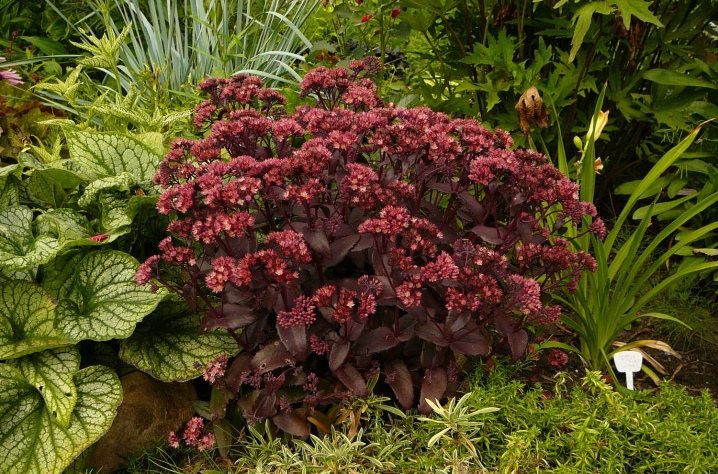
Big stonecrop - a variety of herbaceous perennials found in European countries. Plants have erect, succulent stems covered with flat, oblong-elliptical leaves. The height of this type of succulents is about 40-60 centimeters.
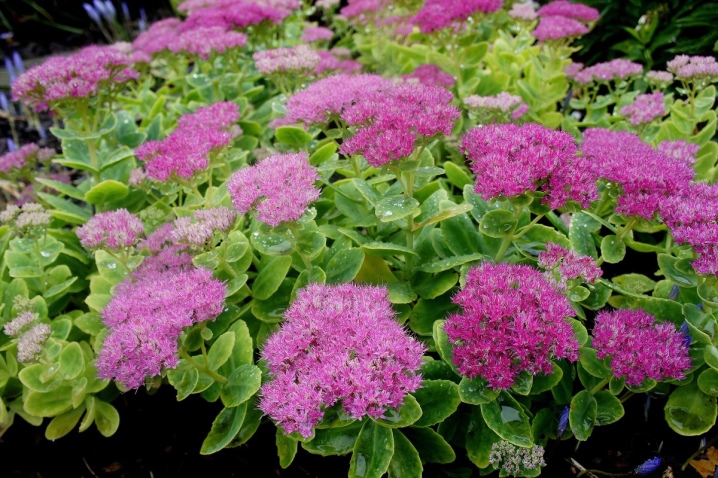
Big stonecrop blooms in mid-summer and blooms until mid-autumn. The inflorescences are lush, corymbose-paniculate, reaching 5-10 centimeters in diameter. The color of the flowers is pink-red, pistachio-pink or white-yellow.
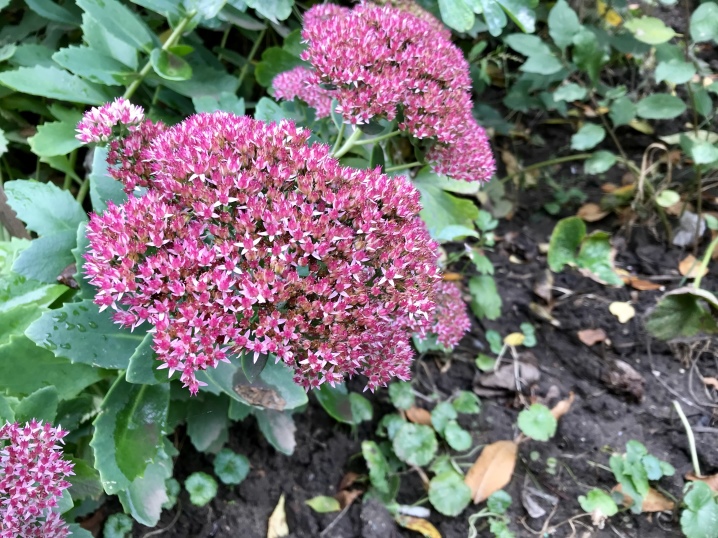
Siebold's sedum - a kind of graceful highly decorative succulents grown by gardeners as ground covers. These are low plants with creeping thin shoots, reaching a height of 10-15 centimeters. The width of the aboveground part of the bush can be about 20-25 centimeters.
The leaves are rounded, small, gray-green, framed by a thin cherry-red stripe (or without it). This type of sedum blooms in the second half of summer or autumn. The flowers are small, star-shaped, pink-lilac or pink-purple, collected in racemose panicles.
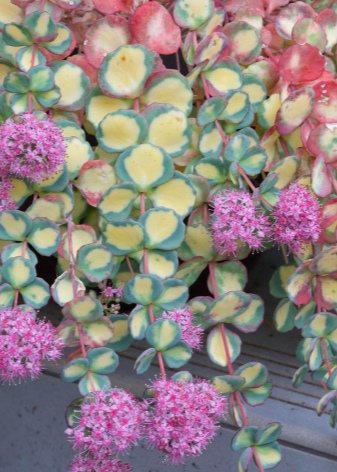

Sedum of Adolphe - a kind of very attractive undersized succulents grown by flower growers as a pot culture. Plants have thin, graceful shoots, reaching 18-20 centimeters in length. The leaves are round, small (up to 3-3.5 centimeters), golden green.
When the plant is grown in a well-lit area, its leaves acquire a bright orange-purple color. Home flowering usually begins in spring. During this period, Adolf sedums form globular inflorescences of a creamy white color.
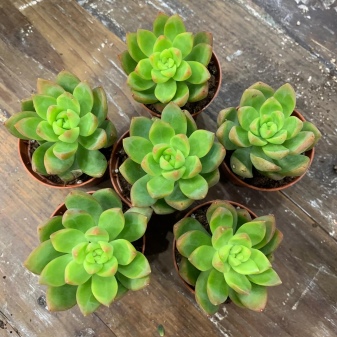

Sedum Evers - a fairly well-known type of undersized succulents, often grown as curbs, ground cover and pot plants. The average height of the bush is about 10 centimeters. Shoots are red-brown, thin, covered with gray-green ovoid leaves. Flowering begins in late summer.


At this time, lush umbellate or corymbose inflorescences of purple-pink color are formed on the tops of the stems.

Sedum rocky or bent - a variety of succulents found in European countries. Plants have straight, upward, pale green stems covered with silvery green leaves. Inflorescences are small loose shields of lemon-yellow color. The beginning of flowering of plants occurs in the second half of summer.


Sedum tenacious - one of the most hardy species of succulent perennials, widespread in Western Siberia. The average plant height is 30-35 centimeters. Stems are straight, reddish, covered with broadly lanceolate leaves. Flowering lasts from June to August. Inflorescences are voluminous sun-yellow shields or umbrellas.

Short-leaved sedum - a kind of unpretentious succulent plants that form lush compact bushes. Plant height is about 10-15 centimeters. Stems are very thin, dense, tightly fitting to each other. The leaves are tiny, rounded, bluish green or pearl green.
When grown at home, sedums of this species bloom in winter. Inflorescences are small, silvery white.


Thick-leaved sedum (dasiphyllum) - a wild species, well known to many growers. Sedum of this species is often grown as ground cover, curb and pot plants. This succulent grows rapidly, forming dense and dense clumps.Branching shoots, reaching 20-25 centimeters in length, densely covered with fleshy bluish-blue or gray-green leaves. The flowers are star-shaped, creamy pink or yellow-pink.

Sedum thin - a kind of low-growing graceful succulents grown by gardeners as ground covers. Sedum of this species grows rapidly, forming a dense cover 5-8 centimeters high. Plants have short, upward-looking stems covered with thick bluish-green leaves.

Sedum spanish - a variety of very original dwarf sedums, popular with landscape designers and florists. Plant height ranges from 5 to 15 centimeters. Stems are graceful, branching, smooth or pubescent. Leaves are linear, thick, pointed.


Under the bright sun, the pale green color of the leaves changes to pink-red.


Sedum of Nussbaumer - an interesting variety of stunted stonecrops, which grow in Mexico. The length of the creeping stems of these plants usually does not exceed 20 centimeters. The stems are covered with fleshy oblong leaves of olive-golden or pink-beige color with a slight reddish tint. The flowers are small, silvery white, star-shaped.


Sedum Rubrotinktum (another name - red-colored sedum) is a type of undersized succulents growing in Mexico. The plant is remarkable for its original coloration, which changes during the summer. The stems are thick, juicy, reaching 15-20 centimeters in length. Leaves are fleshy, bright green, glossy, short, bean-shaped. Under the bright sun, the leaves of the plant take on a purple-red hue.
Flowering usually begins in mid-spring. The flowers are star-shaped, lemon-yellow, collected in lush paniculate inflorescences.

Sedum thick-leaved (pachyphillum) Is another interesting species of succulent perennials, native to Mexico. The average plant height is 15-18 centimeters. Stems are graceful, fragile, densely covered with elongated bean-like leaves of gray-green color. When plants are grown in full sun, the tips of their leaves turn cherry red.

Hybrid sedum - a type of stunted stonecrops growing in the southwestern part of Russia, as well as in the territory of the countries of Central Asia. Plants have branching creeping stems, densely covered with dark green obovate or elliptical leaves. The height of hybrid sedums is about 10-15 centimeters.


The flowers are star-shaped, collected in openwork shields or umbrellas.

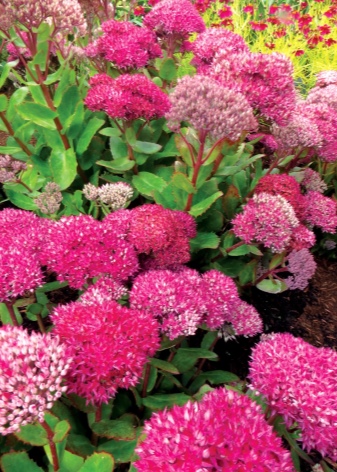
Stonecrop Kamchatka - a kind of unpretentious sedum, suitable for growing in regions with a harsh climate. Plant height can vary from 15 to 30 centimeters. Stems ascending, covered with large fleshy leaves. The beginning of flowering is June. The flowers are small, yellow-red or yellow-orange.

Sedum of Lydia - a variety of low-growing succulents grown by gardeners as a ground cover. Plants grow rather quickly, forming clumps about 8-10 centimeters high. Stems are short, highly branched, creeping or creeping. During drought, the gray-green leaves of the plants take on a reddish tint.
Lydian sedum blooms in early summer. Flowers are medium-sized, white-pink or creamy-pink, collected in small umbrellas.

Sedum six-row (other names - hexagonal or hexagonal sedum) - a type of undersized sedums, common in Asia and Europe. Growing up, hexagonal stonecrops form very attractive clumps up to 10 centimeters high. The leaves are small, pale green, short, cylindrical. Flowering begins in June-July. The flowers are lemon yellow, star-shaped.

Sedum spatulate - a type of low-growing ground cover sedum, found in the western part of North America. Plants have creeping stems covered with short rounded leaves.The color of the leaves is gray-green with a silvery sheen.

The flowers are small, bright yellow, collected in small umbrellas or shields.

Sedum false - a type of succulent perennials, which is widely used in ornamental gardening. Stems creeping or ascending, reaching 5-25 centimeters in length. Leaves are light or dark green, fleshy, flat, widened at the top. The flowers are small, creamy pink or purple-pink, collected in corymbose inflorescences.

Sedum Steel - a kind of very unpretentious stonecrops, whose homeland is Mexico. Plants form compact bushes, reaching 25 cm in height and 30 cm in diameter. The leaves are thick, orange-red, pink-red or dark green with a reddish tint. The flowers are star-shaped, golden yellow, reaching 1-1.2 cm in diameter.

Sedum of Middendorf - a kind of very graceful sedum, often used by gardeners to decorate rock gardens. The average plant height varies from 10 to 30 centimeters. Stems ascending, dark, juicy. The leaves are narrow, glossy, emerald green. The flowers are star-shaped, yellow-orange.

Escaping sedum - a fairly well-known variety of ground cover sedum. Plants grow rapidly, forming dense emerald clumps up to 10 centimeters high. The average height of flowering shoots is 20-25 centimeters. Sedums of this species bloom in June. The flowers are small, white and pink.

Popular varieties
"Burrito" - a very famous variety of sedums, which is widely used in indoor floriculture. Plants have long flowing stems covered with small bean-shaped leaves. Sedums of this variety are usually grown as ampelous plants.

"Tricolor" - a popular variety of stonecrop, recommended for cultivation as a ground cover. Plant height does not exceed 15 centimeters. The leaves are rounded, mint green, decorated with a beige-pink border.


During the flowering period, the plants form numerous lush umbrellas of bright pink color.

"Matron" - a spectacular variety of prominent sedum, often used to decorate garden plots. The plant forms a compact shrub with a height of 60-65 centimeters. Stems are erect, branching, cherry-red. The leaves are dark green, decorated with purple edging, elliptical. Inflorescences are dense white-pink shields.

"Blue Pearl" - the original variety of low-growing sedum, usually grown in gardens as a ground cover or curb plant. A striking feature of stonecrops of this variety are juicy, rounded lilac leaves. The flowers are small, crimson-pink, collected in small shields.


Thunderhead - a flowering variety of ordinary sedum, which is widely used in ornamental gardening. Plant height can reach 70-80 centimeters. Stems are erect, purple-brown. Flowering occurs in the second half of summer. Inflorescences are large, very lush, paniculate or corymbose. The color of the flowers is purple-crimson.

"Purple Emperor" - a very effective variety of hybrid sedum with an unusual color. The plant forms a beautiful compact, multi-stemmed shrub. The color of the stems and flowering arrows ranges from cherry red to purple-violet. The leaves are wide, fleshy, glossy, purple-burgundy, ovoid or elliptical in shape.


The flowers are white-pink or pink-red, collected in globular inflorescences.
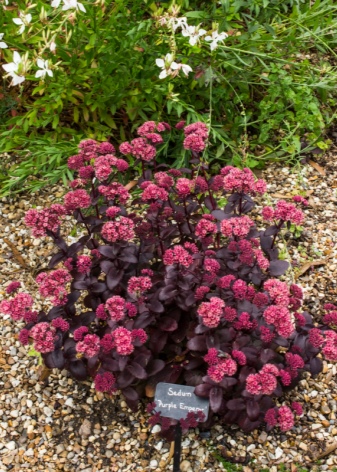

"Charles" - a highly decorative variety of hybrid sedum, valued for its bright and colorful flowering. Plants form compact bushes 35-45 centimeters high. Branching stems, erect, red-brown. The leaves are round, glossy, light or dark green. Inflorescences - voluminous and dense panicles of crimson-pink color.

Angelina - the original variety of rock sedum, recommended for cultivation as a ground cover.Plant height varies from 15 to 20 centimeters. The succulent needle-like leaves are initially golden yellow in color, which subsequently change to a bright orange color.

Red Cowley - unpretentious and very effective variety, recommended for growing in rock gardens. The average plant height is 30-35 centimeters. Stems are dense, purple-violet, covered with broad glossy ovoid leaves.


Abundant flowering, beginning in July and continuing until autumn. Inflorescences are lush crimson-scarlet panicles.

Frosty Morne - late flowering unpretentious variety of sedums, recommended for growing in the open field. The bushes are compact, graceful, multi-stemmed, reaching 30-40 centimeters in height. The leaves are round, juicy, pale green, decorated with a light border. Flowering occurs in autumn and continues until frost. Inflorescences are dense, small shields of creamy pink color.

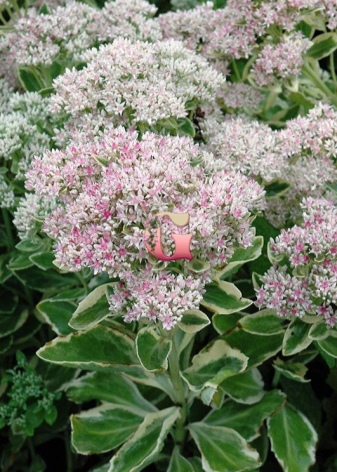
"Diamond" - one of the most famous varieties of stunted sedum, valued for its long and bright flowering. Plants form compact bushes up to 30 centimeters high. Flowering time - August-November. The inflorescences are voluminous, pale pink, effectively contrasting with the pale green foliage.

Cape blanco - an interesting variety of low-growing sedums, used to decorate rock gardens, framing garden paths. Plants grow slowly, forming neat clumps up to 7 centimeters high. The leaves are rounded, gray-blue in color with a pearl tint. Flowers are small, golden yellow.

Touchdown teak - a highly decorative variety of dwarf stonecrop with burgundy-brown foliage. The average plant height is 25 centimeters.

Flowering occurs at the end of summer. The flowers are coral red, gathered in lush umbrellas.

"Lizard" - a very unusual variety of low-growing sedums, suitable for growing both at home and in the garden. Plants have dense creeping stems, densely covered with elongated fleshy leaves. Plant height usually does not exceed 15 centimeters. The color of the leaves is silvery green. The flowers are star-shaped, snow-white or creamy pink.

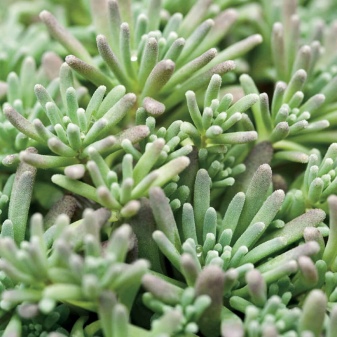
How to choose?
When planning to grow sedums in your garden or in your home, you should familiarize yourself in advance with the characteristics of the most interesting varieties and varieties. One of the important parameters is the height of the plants. So, based on this criterion, the entire variety of representatives of this genus can be divided into the following groups:


- ground cover or undersized (up to 10-20 centimeters high);

- medium-sized (up to 20-40 centimeters high);

- tall (from 50 centimeters and above)

Ground cover and undersized sedums are equally suitable for growing both indoors and outdoors. Experienced gardeners recommend using medium and tall varieties of sedums to decorate flower beds and flower beds.

Another significant characteristic is the shape (directionality) of sedum stems. So, sedums with creeping or creeping stems are best purchased for further cultivation in the open field as ground covers or in pots in the form of ampelous plants... Sedums with erect stems are ideal for single cultivation in flowerpots or flower beds.

The following video will tell you more about stonecropping.






































































































The comment was sent successfully.